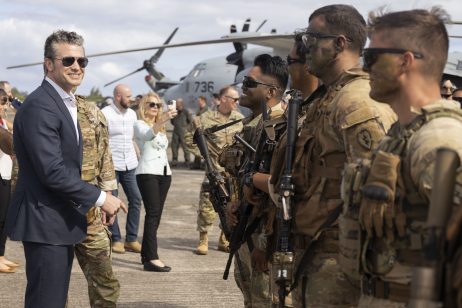Despite all the noise surrounding Trump’s return to the White House, one area where things have remained relatively steady is his administration’s defense approach in Asia. While his economic policies like the massive new Tariffs have raised eyebrows, the U.S. seems to be sticking to its commitments in the Indo-Pacific when it comes to security.
U.S. Defense Secretary Pete Hegseth recently wrapped up his first tour of the region, visiting Hawaii, the Philippines, and Japan. His speeches may have had a distinct “America First” tone, but at their core, they signaled continuity rather than radical change. He emphasized that the Indo-Pacific remains the U.S.’s top priority, referencing Trump’s 2017 speech in Vietnam as the foundation for this commitment. In Manila, he doubled down, promising an “unprecedented” level of military presence in the region.
When it comes to China, the administration is sticking to the strategy of deterrence, making it clear that the U.S. and its allies won’t back down in the face of Chinese military aggression. While Hegseth’s words were blunt calling out “Communist Chinese military aggression” the actual policy is pretty much in line with what the Biden administration was already doing. The focus remains on strengthening alliances and maintaining a credible military presence.
One notable shift, though, is Trump’s emphasis on “burden-sharing.” Hegseth made it clear that U.S. allies need to step up their defense spending, with hints that Washington will be pushing for greater military purchases from the U.S. While this isn’t entirely new Japan, for example, faced similar pressure during Trump’s first term it’s a sign that allies should prepare for more hard bargaining.
At the same time, the administration isn’t just looking to balance the books; they’re also modernizing alliances. Recent deals with Australia, India, Japan, and the Philippines show that the U.S. is serious about strengthening its military partnerships. The recent trilateral naval exercises with Japan and the Philippines in the South China Sea reinforce this strategy, as does the continued support for regional security groups like AUKUS and the Quad.
For now, at least, these moves should reassure U.S. allies in Asia that security commitments remain intact. But there’s still plenty to be concerned about. Trump’s aggressive trade policies and the erosion of U.S. soft power could undermine these defense efforts in the long run. Plus, with renewed military focus on the Middle East and even at the U.S.-Mexico border, there are questions about how much bandwidth Washington really has for Asia.
So while Hegseth’s trip may have provided a temporary sigh of relief, the big question remains: Can Trump’s “America First” approach balance military strength with smart diplomacy in the Indo-Pacific? That’s still up in the air.
